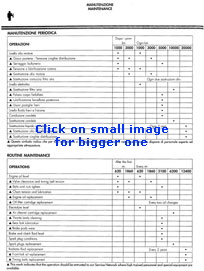|
This is one of those subjects where there is no right or wrong; no black or white, just an ever-varying shade of grey. What follows is an attempt to put some structure on the reasons for
certain maintenance schedules and the way in which you should measure your use of your Ducati.
The manufacturer of any product sets a considered period for its maintenance, the paint on my conservatory is up for about five years, if I don't paint it by then the structure can start to
suffer damage from the elements. It will stay up and perform adequately for many years however, just not as long or nicely as if I give it the required maintenance. The Swatch on my wrist will go around
five years on one battery, if I fit a new battery then the next thing that happens is that the strap breaks or it dies any way because it is designed to last only so long, and its time is now up.
A motorcycle is just the same; some will last for a very long time, especially if they get regular maintenance; some have a lifespan in mind. Ducati's are firmly in the first
category; my little 50cc scooter, I rather suspect, is in the latter.
The paint analogy is quite robust, if you had a conservatory in particularly unpleasant conditions you would want to repaint it more often than if you lived in the south of France where as
far as I can see the paint gets redone every third millennium.
Preventative maintenance schedules for the Street.
Ducati's have come a long way in the last ten years, after nearly twenty years on all sorts of bikes I caught the Ducati bug from a 907ie Paso, this really makes me one of the new guys. But
it also means that I have been around long enough to see some pretty major changes to the build quality and the attitudes of both the guys selling bikes as well as the people buying them.
 The 900 two-valve service book I have in front of me is dated 1991; it is the service manual for that first 907ie.
The scanned first page is alongside, you will note that the service interval is a bit shorter than we have come used to over the last few years, 1860 miles (3000 km) for a belt
tension and. valve clearance check, oil as well. The clearance that are recommended are also quite interesting, opening clearances were set at 0.10mm (4 thou), closers
though are at a much more challenging Nil to 0.02mm (that's nothing to .07 thou for you rednecks out there.). The combination of close clearances and regular maintenance lead to machines that ran really sweet down
at low revs (at higher revs the faster rising gas pressure in the combustion chamber finishes the process of closing a desmo valve in any event), unfortunately it also put off
a lot of people because of the cost and hassle of ownership. The 900 two-valve service book I have in front of me is dated 1991; it is the service manual for that first 907ie.
The scanned first page is alongside, you will note that the service interval is a bit shorter than we have come used to over the last few years, 1860 miles (3000 km) for a belt
tension and. valve clearance check, oil as well. The clearance that are recommended are also quite interesting, opening clearances were set at 0.10mm (4 thou), closers
though are at a much more challenging Nil to 0.02mm (that's nothing to .07 thou for you rednecks out there.). The combination of close clearances and regular maintenance lead to machines that ran really sweet down
at low revs (at higher revs the faster rising gas pressure in the combustion chamber finishes the process of closing a desmo valve in any event), unfortunately it also put off
a lot of people because of the cost and hassle of ownership.
Getting the mileage
Picture yourself as a Cagiva employee or consultant in the early nineties charged with selling more bikes one thing you can do to help the salesmen is look
at the cost of ownership, and reduce it. The new schedules have been out for a few years now, regular services are now at 6000 miles, the acceptable clearances are wider, now you can have
Intake openers at 0.10mm to 0.12 when the bike is built but anything between 0.05 and 0.12 is OK at a service. On the closer it is even more generous, 0.03 to 0.05 when the bike is built, but 0
.03 to 0.20 (!) in a service. Its no wonder the bikes never need their valves adjusting, and its no wonder why you get a 'they all do that sir' response when you complain about the quality of the
low RPM running, the valves are flapping all over the place.
Don't get me wrong, the service schedule, as set now is adequate, for every day road use. It is described by the factory as a preventative maintenance schedule, its not dangerous or
unacceptable, indeed it's financially excellent. It's just that some of the perfectionists (er, that'll be us then!) think it is too generous in terms of acceptable clearances. Progress with the quality
of oils and filters and some materials undoubtedly have helped the factory decide that 6000 miles is a reasonable distance between services for wear purposes, and I am not going to tell them
they are wrong. Its just that if you are going to wait that long it would be nice to get that 'crisp and responsive' feeling you had when it was new back again when it is serviced. As there is no
one to stop me making a small commercial plug now I will just point out that the 2V Full Monty and the Monster tune-up both send you away with your bikes clearances down near the old
settings, which is what I would hope you would expect from us.
 The same considerations are true for the 4 valve motors, different clearances and mileages but the same extension of
time and a commensurate increase in the range of acceptable clearances. The 1992 888 manual sets the minor service at 3000 miles, or 5000 kms for the metrically
minded; at that service you are supposed to do the valves, belt adjustment and oil and filter, you are even suppose to check the cylinder head nuts… These days the work for an
'on the road' service is the same, but at 6000 miles. The same considerations are true for the 4 valve motors, different clearances and mileages but the same extension of
time and a commensurate increase in the range of acceptable clearances. The 1992 888 manual sets the minor service at 3000 miles, or 5000 kms for the metrically
minded; at that service you are supposed to do the valves, belt adjustment and oil and filter, you are even suppose to check the cylinder head nuts… These days the work for an
'on the road' service is the same, but at 6000 miles.
Again the tolerances are much tighter in the early years, for the original 888 (same cams as a current Biposto mind) the openers were supposed to be maintained around 5 thou on
the 888 and closers between 2 to 3 thou. On the 4 valves stronger hairsprings have been fitted in the later years (emissions and noise being the reasons) and clearances are
again allowed to be larger, I cannot imagine why. The 2001 officially acceptable clearances for the 4 valve motors (pre Testatretta) allow an intake closer to have a clearance of 0
.25mm (that's 10 thou), and an exhaust closer to be 0.20mm (9 thou) and be called within spec. Again the way we think means that when we first see a bike we want to prepare it properly, i.e. a Full Monty
and once that is done we just need to keep the bike maintained with one of our 4V services at every appropriate period. For all of our 4V services we take the heads off, we clean the seats
and reshim them properly. The only question in our minds is 'what is the appropriate period?'
Track use, or thrashing it
Now, the sharp eyed amongst you will have noticed the 'on the road' qualifications above. This
brings us to the second part of the story. As noted at the start, the conservatory analogy allowed for shorter periods between maintenance when conditions are less pleasant. If we accept the
6000 mile road use service intervals are OK, (even if, as a company, we would then like to put the clearances back down to a more accurate spec than the one held out officially as 'acceptable')
we have to then ask what conditions can be considered worthy of additional attention and therefore shorter service periods.
The answer is track use; the more you thrash it the quicker any machine is going to need attention, Ducati may have increased the service intervals to 6000 miles but I absolutely refuse to
believe they thought 6000 miles between services was a good idea if the owner was flailing it round a racetrack. For an example we can show you the various factory approved service
intervals for a 748R in its various guises. This bike is sold as a roadster, albeit with pretty hot cams and very big valves for its size, it can also rev, 11400 rpm on the road, 12400 rpm on the
RS racer version. As far as engine reliability is concerned the RS has higher quality valves, and cams with the most aggressive opening and closing ramps of any Ducati ever made, the rest of
the bike is very standard.
  You will note the way in which
the standard 748R and 748R production racing schedules differ, for road use the services are the standard 600-mile. For serious racing use though the oil, filters spark plugs and belts are to be
changed every 1000Km (650 track miles), the engine opened and the conrod bearings, rockers and valves checked and changed every 2000 km (1300 track miles), at 4000 km the list is so long it
is cheaper to bin the engine. You will note the way in which
the standard 748R and 748R production racing schedules differ, for road use the services are the standard 600-mile. For serious racing use though the oil, filters spark plugs and belts are to be
changed every 1000Km (650 track miles), the engine opened and the conrod bearings, rockers and valves checked and changed every 2000 km (1300 track miles), at 4000 km the list is so long it
is cheaper to bin the engine.
A bit of perspective.
Now, having scared the pants off everyone who rides their Ducati on a track lets consider this a
little closer; Ducati wants to have a reputation for not breaking down, for racing therefore, in true aerospace fashion they therefore issue a maintenance schedule that absolutely ensures no Ducati
ever breaks down 'on track'. Each component in an engine is examined and given an estimated 'life', the schedule is designed to ensure no component gets to the point at which it might break
before it is replaced. It is the reason why there are a lot of perfectly good looking but completely knackered second hand racing parts in every tuners bin. For the sake of argument (and this is not
a recommendation, lawyers please note!!) lets say we could go another 50% on some of the items in the schedule mileages in racing with minimal (but nevertheless some) risk. The schedules
do not mention the regular belt tension checks and oil changes (when we are racing every 200 miles for both).
It has also to be said that some riders can be more abusive than others, especially when a slower
rider is using the engines power to make up for their lack of riding skill (now don't get upset about this, how do you think I started getting in to engine preparation!?!).
Don't forget though that while we were doing 200 miles in practice and race every British Supersport Championship meeting in 2000, a more typical club meet will give you ten minutes of
practice and three 10 minute races, lets assume a generous average speed of 100 mph and we are looking at 40 minutes per outing; or 100km (66miles). That means that you would have to do
ten rounds to get to Ducati's very pessimistic first maintenance point. With either longer races or 20 race meetings per year (which from experience takes some doing) you would need the 2000
km serious strip and check every winter. To get to the recommended 'throw the engine away' stage you would have had to have done 4 years of pretty committed club racing, that's one year
longer than the average racers amateur career in this country.
Track Day use.
Track days are not usually as abusive as racing, most riders are just trying to have a good time,
to ride fast with their friends, I do. Although if you are always at the front of the fast group and all the people you meet say you should be racing then maybe you should look at the production
racing service schedule again. For the rest of us lets just think about how long we are actually on track, lets say 80mph average at most serious tracks, lets say seven 15 minute sessions; lets
also say we double the pessimistic Ducati racing schedule because we don't thrash it that much. A quick total shows 140 miles, or 225 km per track day, max, and we should get worried about a
good service at somewhere around 2000 km/1400 miles of regular track use. Personally I think that's about right, although I would change the oil and check belt tensions every 3 or 4 track
outings regardless of anything else, its relatively cheap and its good insurance.
For the less committed lets not get all nervous, going on track is not going to trash your bike (as
long as you stay on it that is!), if your oil has already done 2000 miles I guess new fresh stuff in the bike the night before would make sure there is less wear, and a couple of track days every
6000 mile maintenance period shouldn't be a problem, but 100% track day use should realistically mean a good service around the 1500 mile mark.
Some of the bikes in the range are particularly easy going on their componentry, we like to build 853 Bip's because you need to rev them less than 748's for the same speed and our 94mm 853
pistons weigh the same as the factory 748 ones; the Biposto cams profile is really gentle on the valves and rockers too. Be wary of over revving 996 Bips; with their big 98mm pistons and steel
rods they don't like it. 748R's rev harder than 996SPS's so the heads need more TLC than the 996SPS.
Its all about shades of grey, being honest with yourself about the way you use/abuse the machine and the mileages you do. Regular high revs mean higher wear rates. Its also about deciding
whether the service you want is one of those 'we can make it last 6000 miles between services' style preventative maintenance checks or a more serious inspection of the machine. We are happy to say we will do the latter, for those of you happy to take the former you are reading the
wrong website, please go to your normal streetbike dealer.
As a bit of a postscript however I thought I would show you the official 2000 racing maintenance schedule for the 748RS, this is with world and top national championship racing in mind.
Supersport (as my wallet found out to its cost) is very abusive to the machinery, the rules allow higher revs and tuning for power but do not allow parts to be uprated to cope with it. Ducati's
Supersport RS service schedule is therefore more severe than the 996RS Corsa one (Superbike rules allow for the replacement of major engine components with stronger 'racing only' parts) and
is the sort of schedule that one of the new MotoGP four stroke GP racers would be expected to follow. A typical race meeting would involve 200 miles using the revlimiter as a shift point,
feeding the clutch out at the start with the throttle at 12000 rpm, then having three gears kicked out without the clutch, every slow corner.
 For more details of this serious and radical extreme, the roadbike being raced to its limit, have a look at the 748R – 748RS article. For more details of this serious and radical extreme, the roadbike being raced to its limit, have a look at the 748R – 748RS article.
There are a lot of things to think about, and few of them are set in stone, but to summarise:
- The Standard Ducati 6000 mile service intervals are perfectly acceptable for regular road only use.
- We believe the bikes run better with more accurately maintained valve clearances.
- We know the bikes run better after they have been correctly set up.
- For the occasional track day give the bike a chance and go out with fresh (15w/50 Fully Synthetic) oil in the engine.
- For regular track day use a serious service such as the 'Full Monty' will ensure it is in good condition before being asked to perform at its best.
- For regular track days consider shortening the service periods.
- For 100% track day use we think that a service every 1500 miles with oils changed and belts inspected at half that is a good idea.
- For real race use the Ducati Production racing service schedule is one that will keep your bike in 100% good condition, it is based on aerospace 'replace it before it deteriorates'
logic, some mileages could be stretched but this is very much at your own risk. Regardless of this schedule we would inspect and adjust the belts, check and adjust valve clearances
and change the oil every 250 racing miles for optimum performance and reliability.
Neil Spalding
|